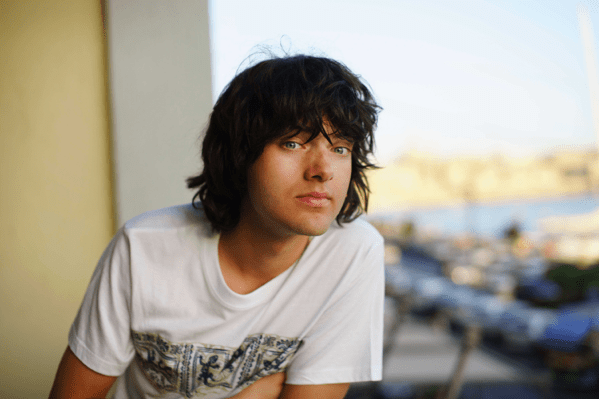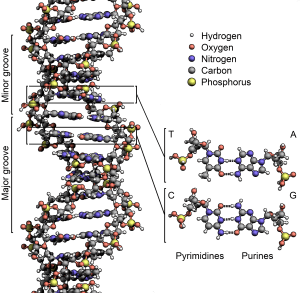“For society to progress, we should not only move forward but also cleanup after ourselves.”1

By NOAA | Courtesy of Wikimedia Commons
Over the last forty years, our oceans have been filling with tons of plastic debris. The plastic is carried by the ocean currents and it all converges in five major accumulation zones, commonly called “Garbage Patches.”2 Many scientists predict that if this problem is not solved, there will be major consequences. Garbage will block the sunlight in the oceans, resulting in many species of sea plants and animals dying. Moreover, the environment will be affected in such ways that the entire food chain of the world will suffer major changes. Dutch inventor Boyan Slat has come up with an idea to solve this problem.3
Boyan Slat is a 24-year-old Dutch inventor, who has been interested in engineering projects since he was very young. At the age of fourteen, he even set a Guinness World Record by launching 213 water rockets at the same time.4 When he was sixteen, he went diving in the waters of Greece and was so surprised to see more plastic underwater than fish. That was the moment when Slat began the idea of cleaning up the ocean. Over the last forty years, millions of tons of plastic have entered the oceans creating huge garbage patches. The largest such patch is located between Hawaii and California. After his trip to Greece, Boyan became obsessed with this problem. During high-school, all of his science projects were about understanding this problem and trying to solve the “million-dollar” question “why this cleanup is considered impossible?”5

After high-school, Boyan was invited to TEDtx to tell the world his idea. At first, his ideas didn’t seem to be really interesting to the public, so he went on with his life. He started working as an aerospace engineer in TU Delft, but he just couldn’t let go of his idea. But the simple thought of not being able to come up with a solution to this major problem was killing him. He was thinking about the terrible consequences, in several years, for the planet if no one did anything.6
After several months he came into the spotlight again because some news sites had picked up his TED speech and became interested in his story. Slat even dropped out of college to pursue his dream.7
He had always enjoyed solving problems and puzzles. But this time was going to be different. This time the puzzle was to get rid of the plastic in the oceans. He just had to find the perfect pieces to accomplish that. At the young age of eighteen, he founded a non-profit organization called The Ocean Cleanup, in order to develop new technology to tackle this almost impossible task.8
And this is when the real adventure began for Slat. Instead of picking up all the plastic bottles with nets, which according to experts it would cost millions of dollars and take thousands of years, his idea was to use the power of natural currents to gather plastic into long floating rubber barriers. But developing this great plan wasn’t an easy task. It required money, time, and many experts in different fields. In an interview, Slat said “When I started, I thought I would likely fail, and I still might, but considering the scale of the problem, it was important to at least try.”9
His ideas started coming together when several experts, such as engineers, oceanographers, recycling companies, and scientists volunteered to complete a study, which ended up indicating that the The Ocean Cleanup project had a feasible and viable method for removing large amounts of plastic. But this was only the first step. Slat still needed a lot of money to start the project. So his next step was to take his story and project to the rest of the world. He has since gained the support of 160 countries, 38,000 funders, and collected over 2 million USD. With this money, he was closer to accomplishing his dream, but, again, this was just another piece of a big puzzle.10

Later, The Ocean Cleanup started developing prototypes, then getting into trials, failing and learning from mistakes, and finally the got it right. They mapped an area of 3.5 million squared kilometers of plastic and marine debris, known as the “great pacific garbage patch.” After that, Slat gave an interview arguing that most people had an image of this patch as an island where you can practically walk on, but that couldn’t be more wrong. It stretches for millions of kilometers and it would take thousands of years to clean it up.11 So he targeted that area to clean first. The first Ocean Cleanup system was launched on September 8, 2018. He is hoping to clean up to 50% within five years.12
This amazing story is only getting started, so if you want to follow the progress of this project, you can follow their official organization page (www.theoceancleanup.com).
- The Ocean Cleanup, “The largest Cleanup history,” The Ocean Cleanup, June 6, 2017. Accessed September 8. www.theoceancleanup.com. ↵
- NOAA, “Great Pacific Garbage Patch,” National Geographic, June 5, 2015. Accessed September 8. https://www.nationalgeographic.org/encyclopedia/great-pacific-garbage-patch/. ↵
- U.S. Government Publishing Office, “Endangered status for North Pacific and North Atlantic Right Whales,” (Federal register: Vol. 73, No. 45. Thursday, 2008), 12024-12030. ↵
- Viveke Venema, “The Dutch boy mopping up a sea of plastic,” BBC News, October 17, 2017. Accessed September 7. https://www.bbc.com/news/magazine-29631332. ↵
- Susan Caminiti, “Thiel backing 22-year-old’s dream to clean up world’s oceans,” CNBC.com, April 22, 2017. Accessed September 5. https://www.cnbc.com/2017/04/20/thiel-benioff-backing-22-year-olds-dream-to-clean-up-worlds-oceans.html. ↵
- The Ocean Cleanup, “How it all began,” The Ocean Cleanup, June 6, 2017. Accessed September 8. www.theoceancleanup.com. ↵
- The Ocean Cleanup, “How it all began,” The Ocean Cleanup, June 6, 2017. Accessed September 8. www.theoceancleanup.com. ↵
- Susan Caminiti, “Thiel backing 22-year-old’s dream to clean up world’s oceans,” CNBC.com, April 22, 2017. Accessed September 5. https://www.cnbc.com/2017/04/20/thiel-benioff-backing-22-year-olds-dream-to-clean-up-worlds-oceans.html. ↵
- Viveke Venema, “The Dutch boy mopping up a sea of plastic,” BBC News, October 17, 2017. Accessed September 7. https://www.bbc.com/news/magazine-29631332. ↵
- The Ocean Cleanup, “Milestones,” The Ocean Cleanup, June 6, 2017. Accused September 8. www.theoceancleanup.com. ↵
- Marian Liu, “Great Pacific Garbage Patch Now Three Times the Size of France,” CNN, 23 Mar. 2018. Accessed September 6 2018. www.cnn.com/2018/03/23/world/plastic-great-pacific-garbage-patch-intl/index.html. ↵
- The Ocean Cleanup, “Milestones,” The Ocean Cleanup, June 6, 2017. Accessed September 8. www.theoceancleanup.com. ↵



78 comments
Gabriela Ochoa
This is a really great article and tackles an important thing in the world. I have heard of the garbage patch before but never knew it was so big. I had never heard of Boyan Slat and his project but it is truly amazing. I like his idea to start in one place and to get the plastic from there and to continue from that point. I also found it amazing that he expects to get 50% out in 5 years. I’m glad that someone is finally doing something to help the wildlife that lives in the ocean from further being affected by the trash and is doing it in a great way.
Eric Ortega Rodriguez
Wow, this was truly a very fascinating article. I was surprised that I have not heard of Boyan Slant before, though his work seems amazing. What I most admire about Slant is that he was willing to put in the work even when the goal seemed very far away. This article made me want to look more into The Ocean Cleanup project and watch Slant’s TED talk. Especially because pollution is such a huge issue which needs to be addressed. Overall, this was a very informative article.
Jennifer Salas
I recently saw the TED talk that Boyan Slant did and I was inspired to do more for the planet. I feel that we don’t often think about the amount of pollution there is and how harmful it is to the planet. I believe that his idea will help tremendously, but as a society we need to do better and make sure we pick up after ourselves and take in consideration the planets needs.
Christopher Vasquez
Boyan Slat is a man that wants the best for humanity. Realizing that the world only has a finite amount of resources, he intends to maximize the resources we have by picking up the trash in the ocean; this would prevent many ecological problems, such as animals dying off, and allow the world to live longer. I think his idea of using the natural currents to gather plastic into rubber barriers is a fantastic idea! I hope that his ideas soon catch on because we all need a greener planet.
Max Lerma
Thanks for this awesome article! Climate change and global warming are without a doubt two of the greatest challenges our world faces right now. What makes it unique is that it affects every nation and all people not just a small group of us. It is inspiring to hear of projects like the one you detailed in your article. It shows that individuals can come together and use their intellect and will to help take care of the world and its oceans.
Adrian Cook
I believe this project will do great numbers in the near future and it surprises me as I’ve never heard of the ocean cleanup. With majority of the world fearful of global warming, not many people are doing their part to help the world and continuously ignore a big problem at hand. I’m glad someone finally took initiative and decided they were going to be the one to change the world as much as they can. I hope this project succeeds in every way possible and eliminates all trash in the ocean.
William Rittenhouse
This is such a cool project and I’m glad it’s such a committed individual leading it. He seems like a guy that isn’t going to settle for anything other than success. This has been a big problem that we’ve been facing for a while now. I hope we don’t solely focus on clean up though. We also need to direct attention to what’s causing this problem. The problem is pollution. That plastic gets there from us polluting. We need to focus efforts to stop pollution as well as keep finding better ways to clean up after ourselves.
Devin Ramos
I have seen the TED talk that Boyan Slat gave and his idea for cleaning up the ocean. The video shows that a long almost tube like thing would be released from a boat and it would follow the boat and collect all the plastic that is in its path. I like this idea because I believe we are overly polluting our planet and killing the natural wildlife and this is interesting to me to see that other people care about the planet as well and are taking huge steps to clean and help it.
Kathyleen Lauriano
I think this is an amazing idea. I kind of already knew about the big island of trash but never thought to try and read more about it. Its sad that it has taken forever to try an actually do something to help fix this issue in the world. Texas is pretty big I mean can you imagine how much trash there is if its bigger than Texas. This article was very interesting to read. Good job it was well written.
Jose Fernandez
I think this is a great topic for an article! It is something we should all hear about because it is very important for our world. Plastics and other types of garbage are ruining our oceans and a large part of Earth’s population doesn’t even care! There should be more people like Boyan, people who care about this world and put their ideas into action. The article was very well written and I really enjoyed reading it.